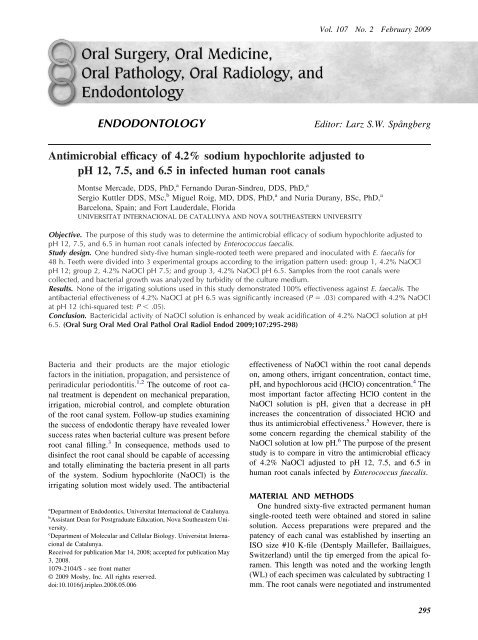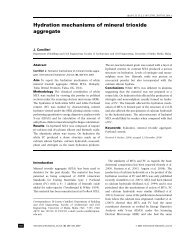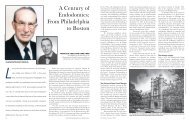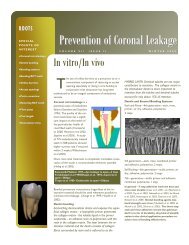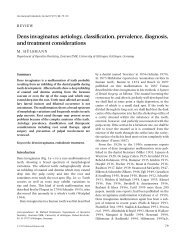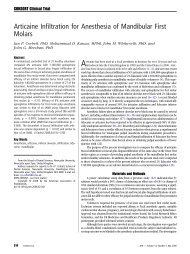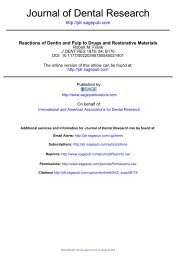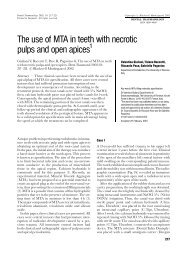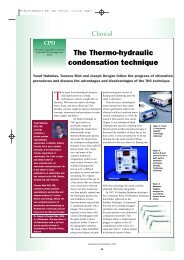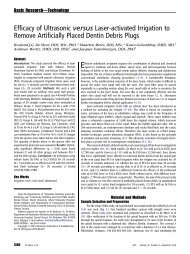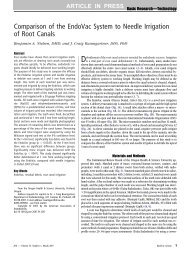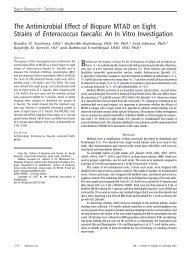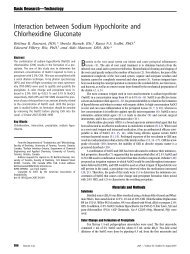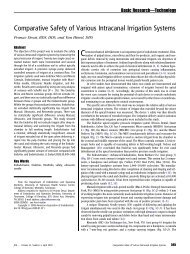Antimicrobial efficacy of 4.2% sodium hypochlorite adjusted to pH 12 ...
Antimicrobial efficacy of 4.2% sodium hypochlorite adjusted to pH 12 ...
Antimicrobial efficacy of 4.2% sodium hypochlorite adjusted to pH 12 ...
Create successful ePaper yourself
Turn your PDF publications into a flip-book with our unique Google optimized e-Paper software.
<strong>Antimicrobial</strong> <strong>efficacy</strong> <strong>of</strong> <strong>4.2%</strong> <strong>sodium</strong> <strong>hypochlorite</strong> <strong>adjusted</strong> <strong>to</strong><br />
<strong>pH</strong> <strong>12</strong>, 7.5, and 6.5 in infected human root canals<br />
Montse Mercade, DDS, PhD, a Fernando Duran-Sindreu, DDS, PhD, a<br />
Sergio Kuttler DDS, MSc, b Miguel Roig, MD, DDS, PhD, a and Nuria Durany, BSc, PhD, a<br />
Barcelona, Spain; and Fort Lauderdale, Florida<br />
UNIVERSITAT INTERNACIONAL DE CATALUNYA AND NOVA SOUTHEASTERN UNIVERSITY<br />
Objective. The purpose <strong>of</strong> this study was <strong>to</strong> determine the antimicrobial <strong>efficacy</strong> <strong>of</strong> <strong>sodium</strong> <strong>hypochlorite</strong> <strong>adjusted</strong> <strong>to</strong><br />
<strong>pH</strong> <strong>12</strong>, 7.5, and 6.5 in human root canals infected by Enterococcus faecalis.<br />
Study design. One hundred sixty-five human single-rooted teeth were prepared and inoculated with E. faecalis for<br />
48 h. Teeth were divided in<strong>to</strong> 3 experimental groups according <strong>to</strong> the irrigation pattern used: group 1, <strong>4.2%</strong> NaOCl<br />
<strong>pH</strong> <strong>12</strong>; group 2, <strong>4.2%</strong> NaOCl <strong>pH</strong> 7.5; and group 3, <strong>4.2%</strong> NaOCl <strong>pH</strong> 6.5. Samples from the root canals were<br />
collected, and bacterial growth was analyzed by turbidity <strong>of</strong> the culture medium.<br />
Results. None <strong>of</strong> the irrigating solutions used in this study demonstrated 100% effectiveness against E. faecalis. The<br />
antibacterial effectiveness <strong>of</strong> <strong>4.2%</strong> NaOCl at <strong>pH</strong> 6.5 was significantly increased (P .03) compared with <strong>4.2%</strong> NaOCl<br />
at <strong>pH</strong> <strong>12</strong> (chi-squared test: P .05).<br />
Conclusion. Bactericidal activity <strong>of</strong> NaOCl solution is enhanced by weak acidification <strong>of</strong> <strong>4.2%</strong> NaOCl solution at <strong>pH</strong><br />
6.5. (Oral Surg Oral Med Oral Pathol Oral Radiol Endod 2009;107:295-298)<br />
Bacteria and their products are the major etiologic<br />
fac<strong>to</strong>rs in the initiation, propagation, and persistence <strong>of</strong><br />
periradicular periodontitis. 1,2 The outcome <strong>of</strong> root canal<br />
treatment is dependent on mechanical preparation,<br />
irrigation, microbial control, and complete obturation<br />
<strong>of</strong> the root canal system. Follow-up studies examining<br />
the success <strong>of</strong> endodontic therapy have revealed lower<br />
success rates when bacterial culture was present before<br />
root canal filling. 3 In consequence, methods used <strong>to</strong><br />
disinfect the root canal should be capable <strong>of</strong> accessing<br />
and <strong>to</strong>tally eliminating the bacteria present in all parts<br />
<strong>of</strong> the system. Sodium <strong>hypochlorite</strong> (NaOCl) is the<br />
irrigating solution most widely used. The antibacterial<br />
a<br />
Department <strong>of</strong> Endodontics, Universitat Internacional de Catalunya.<br />
b<br />
Assistant Dean for Postgraduate Education, Nova Southeastern University.<br />
c<br />
Department <strong>of</strong> Molecular and Cellular Biology. Universitat Internacional<br />
de Catalunya.<br />
Received for publication Mar 14, 2008; accepted for publication May<br />
3, 2008.<br />
1079-2104/$ - see front matter<br />
© 2009 Mosby, Inc. All rights reserved.<br />
doi:10.1016/j.tripleo.2008.05.006<br />
Vol. 107 No. 2 February 2009<br />
ENDODONTOLOGY Edi<strong>to</strong>r: Larz S.W. Spångberg<br />
effectiveness <strong>of</strong> NaOCl within the root canal depends<br />
on, among others, irrigant concentration, contact time,<br />
<strong>pH</strong>, and hypochlorous acid (HClO) concentration. 4 The<br />
most important fac<strong>to</strong>r affecting HClO content in the<br />
NaOCl solution is <strong>pH</strong>, given that a decrease in <strong>pH</strong><br />
increases the concentration <strong>of</strong> dissociated HClO and<br />
thus its antimicrobial effectiveness. 5 However, there is<br />
some concern regarding the chemical stability <strong>of</strong> the<br />
NaOCl solution at low <strong>pH</strong>. 6 The purpose <strong>of</strong> the present<br />
study is <strong>to</strong> compare in vitro the antimicrobial <strong>efficacy</strong><br />
<strong>of</strong> <strong>4.2%</strong> NaOCl <strong>adjusted</strong> <strong>to</strong> <strong>pH</strong> <strong>12</strong>, 7.5, and 6.5 in<br />
human root canals infected by Enterococcus faecalis.<br />
MATERIAL AND METHODS<br />
One hundred sixty-five extracted permanent human<br />
single-rooted teeth were obtained and s<strong>to</strong>red in saline<br />
solution. Access preparations were prepared and the<br />
patency <strong>of</strong> each canal was established by inserting an<br />
ISO size #10 K-file (Dentsply Maillefer, Baillaigues,<br />
Switzerland) until the tip emerged from the apical foramen.<br />
This length was noted and the working length<br />
(WL) <strong>of</strong> each specimen was calculated by subtracting 1<br />
mm. The root canals were negotiated and instrumented<br />
295
OOOOE<br />
296 Mercade et al. February 2009<br />
<strong>to</strong> a size #20 K-type file (Dentsply Maillefer) without<br />
irrigation. The canals were then enlarged <strong>to</strong> an F3<br />
ProTaper rotary file (Dentsply Maillefer) using the sequence<br />
recommended by the manufacturer and with the<br />
aid <strong>of</strong> an electric mo<strong>to</strong>r (Tecnika Vision; Dentsply<br />
Maillefer). Preparation was then completed by using a<br />
40/04 Pr<strong>of</strong>ile at the working length. Irrigation was<br />
performed between each rotary instrument using 1 mL<br />
<strong>4.2%</strong> NaOCl (commercial s<strong>to</strong>ck solution; Henckel<br />
Ibérica, Barcelona, Spain) delivered in a 10-mL syringe.<br />
The smear layer was removed using 20% citric<br />
acid for 1 min and subsequently <strong>4.2%</strong> NaOCl for 5 min.<br />
The apical 3 mm <strong>of</strong> each specimen was covered with<br />
Tetric Ceram (Ivoclar Vivadent, Schaan, Liechtenstein)<br />
<strong>to</strong> prevent any extrusion or leakage <strong>of</strong> material during<br />
root canal preparation and sample collection. Teeth<br />
were mounted vertically in plaster blocks, introduced in<br />
plastic boxes, and sterilized in an au<strong>to</strong>clave at <strong>12</strong>1°C<br />
for 20 min.<br />
The bacteria Enterococcus faecalis (ATCC 292<strong>12</strong>)<br />
was inoculated in a Brain Heart Infusion (BHI)–agar<br />
plate (Difco, Detroit, MI). The plate was incubated<br />
aerobically at 37°C during 48 h <strong>to</strong> allow bacterial<br />
growth. One colony <strong>of</strong> E. faecalis was introduced in a<br />
sterile assay tube containing 5 mL BHI and was incubated<br />
for 48 h at 37°C in a shaker. Tooth specimens<br />
were inoculated with a 10-L bacterial suspension,<br />
previously <strong>adjusted</strong> <strong>to</strong> an optical density <strong>of</strong> 0.5 at 590<br />
nm, using sterile 1 mL tuberculin syringes and incubated<br />
for 48 h. In a previous study we had determined<br />
that a bacterial suspension <strong>of</strong> 0.5 optical density contained<br />
approximately 2 10 9 colony-forming units<br />
(CFU)/mL.<br />
After 48 h <strong>of</strong> bacterial infection, the roots were<br />
randomly assigned <strong>to</strong> 3 experimental groups and 2<br />
control groups, according <strong>to</strong> the irrigants <strong>to</strong> be tested.<br />
All solutions were freshly prepared, and <strong>pH</strong> was determined<br />
by using a digital <strong>pH</strong> meter (<strong>pH</strong>meter basic 20;<br />
Crison, Barcelona, Spain). Irrigant was delivered in the<br />
canals by means <strong>of</strong> a 10-mL plastic syringe with a<br />
23-gauge needle.<br />
Group 1: <strong>4.2%</strong> NaOCl solution (<strong>pH</strong> <strong>12</strong>)<br />
Forty-three root canals inoculated with E. faecalis<br />
were irrigated with 0.2 mL <strong>4.2%</strong> NaOCl (<strong>pH</strong> <strong>12</strong>). The<br />
solution was kept in the canal for 5 min before being<br />
rinsed out with 1 mL 5% thiosulfate (Na 2S 2O 3), which<br />
was then allowed <strong>to</strong> remain in the canal for 1 min,<br />
thereby inactivating the remnants <strong>of</strong> the NaOCl.<br />
Group 2: <strong>4.2%</strong> NaOCl solution (<strong>pH</strong> 7.5)<br />
Forty-two root canals inoculated with E. faecalis<br />
were irrigated with 0.2 mL <strong>4.2%</strong> NaOCl (<strong>pH</strong> 7.5). To<br />
maintain NaOCl at a <strong>pH</strong> <strong>of</strong> 7.5, the solution was pre-<br />
pared mixing 30 mL <strong>4.2%</strong> NaOCl and 0.5 mL 99.5%<br />
acetic acid and allowed <strong>to</strong> settle for 5 min before being<br />
introduced in<strong>to</strong> the canals. The solution was kept in the<br />
canal for 5 min before being rinsed out with 1 mL 5%<br />
Na 2S 2O 3, which was then allowed <strong>to</strong> remain in the<br />
canal for 1 min, thereby inactivating the remnants <strong>of</strong><br />
the NaOCl.<br />
Group 3: <strong>4.2%</strong> NaOCl solution (<strong>pH</strong> 6.5)<br />
Forty-three root canals inoculated with E. faecalis<br />
were irrigated with 0.2 mL <strong>4.2%</strong> NaOCl (<strong>pH</strong> 6.5). To<br />
maintain NaOCl at a <strong>pH</strong> <strong>of</strong> 6.5, the solution was prepared<br />
mixing 30 mL <strong>4.2%</strong> NaOCl and 0.9 mL 99.5%<br />
acetic acid and allowed <strong>to</strong> settle for 5 min before being<br />
introduced in<strong>to</strong> the canals. The solution was kept in the<br />
canal for 5 min before being rinsed out with 1 mL 5%<br />
Na 2S 2O 3, which then was allowed <strong>to</strong> remain in the<br />
canal for 1 min, thereby inactivating the remnants <strong>of</strong><br />
the NaOCl.<br />
Positive control group<br />
Eighteen root canals inoculated with E. faecalis were<br />
irrigated with 5% Na 2S 2O 3 for 5 min.<br />
Negative control group<br />
Eighteen root canals, not inoculated with E. faecalis<br />
but with sterile BHI, were irrigated with 5% Na 2S 2O 3<br />
for 5 min.<br />
Subsequent <strong>to</strong> Na 2S 2O 3 irrigation, #40 sterile paper<br />
points (Dentsply Maillefer) were introduced in<strong>to</strong> the<br />
canals and maintained for 1 min for sample collection.<br />
In each specimen three paper points samples were<br />
collected. The points were individually transfered and<br />
immersed in 5 mL BHI medium and aseptically cultured<br />
in a shaker at 37°C for 72 h. After 72-h incubation,<br />
2 observers examined the tubes in a blinded manner<br />
for the presence <strong>of</strong> turbidity. The number <strong>of</strong><br />
positive and negative samples after treatment was recorded.<br />
Statistical analysis<br />
The results were analyzed statistically by the chisquared<br />
test, and the level <strong>of</strong> significance was set at P<br />
.05.<br />
RESULTS<br />
All positive control samples presented turbidity, revealing<br />
that Na 2S 2O 3 was not <strong>to</strong>xic <strong>to</strong> bacteria at the<br />
concentration used; and none <strong>of</strong> the negative controls<br />
showed turbidity, which confirmed the use <strong>of</strong> an aseptic<br />
technique throughout the experiment. Table I shows the<br />
antimicrobial <strong>efficacy</strong> <strong>of</strong> the different solutions used.<br />
The group <strong>of</strong> teeth irrigated with <strong>4.2%</strong> NaOCl at <strong>pH</strong> <strong>12</strong><br />
presented 60.5% disinfection, whereas the group
OOOOE<br />
Volume 107, Number 2 Mercade et al. 297<br />
Table I. <strong>Antimicrobial</strong> activity <strong>of</strong> irrigants in human<br />
root canals infected by Enterococcus faecalis<br />
Group<br />
Samples,<br />
n<br />
Bacterial<br />
growth, n (%)<br />
No bacterial<br />
growth, n (%)<br />
<strong>4.2%</strong> NaOCl, <strong>pH</strong> <strong>12</strong> 43 17 (39.5%) 26 (60.5%)<br />
<strong>4.2%</strong> NaOCl, <strong>pH</strong> 7.5 42 <strong>12</strong> (27.9%) 30 (72.1%)<br />
<strong>4.2%</strong> NaOCl, <strong>pH</strong> 6.5 43 7 (16.2%) 36 (83.8%)<br />
Positive control 18 18 (100%) 0<br />
Negative control 18 0 18 (100%)<br />
Enterococcus faecalis–infected root canals were irrigated with <strong>4.2%</strong><br />
NaOCl at <strong>pH</strong> <strong>12</strong>, 6.5, and 7.5 for 5 min, and the disinfection capacity<br />
was determined after 72 h <strong>of</strong> incubation at 37°C by recording bacteria<br />
growth observed as turbidity.<br />
treated with <strong>4.2%</strong> NaOCl at <strong>pH</strong> 7.5 presented 72.1%<br />
disinfection, and the group treated with <strong>4.2%</strong> NaOCl at<br />
<strong>pH</strong> 6.5 presented 83.8% disinfection. There was a significant<br />
increase in the disinfecting capacity <strong>of</strong> the<br />
group at <strong>pH</strong> 6.5 with respect <strong>to</strong> the group at <strong>pH</strong> <strong>12</strong> (P<br />
.03), however, the difference was not significant<br />
between the groups at <strong>pH</strong> <strong>12</strong> and at <strong>pH</strong> 7.5 (P .4) or<br />
between the groups at <strong>pH</strong> 7.5 and at <strong>pH</strong> 6.5 (P .27).<br />
DISCUSSION<br />
The antimicrobial <strong>efficacy</strong> <strong>of</strong> intracanal medicaments<br />
has been long investigated using different experimental<br />
models. Various authors have used in vivo<br />
models, 7-10 and others have used in vitro models, such<br />
as infected human teeth 11,<strong>12</strong> or infected bovine<br />
teeth. 13-15 Similar studies have been carried out in test<br />
tubes 16-19 or agar plates, 20-23 but they do not accurately<br />
replicate the conditions in human teeth, because ana<strong>to</strong>mic<br />
hindrances in teeth do not permit direct contact<br />
between the antimicrobial substances and the microorganisms.<br />
19,23 Disagreement among authors may be due<br />
<strong>to</strong> differences in experimental procedures, the bacterial<br />
strains tested, incubation time, and conditions or<br />
growth media used.<br />
Enterococcus faecalis was chosen for several reasons:<br />
It occurs primarily in retreatment scenarios; it has<br />
been extensively used in experimental work in endodontics,<br />
including antiseptic susceptibility 24 ;itsurvives<br />
in root canals as a single organism without the<br />
support <strong>of</strong> other bacteria 8 ; and it is an easy-<strong>to</strong>-grow<br />
bacteria in the labora<strong>to</strong>ry. 14 Bacteria were allowed <strong>to</strong><br />
grow in the canals for 48 h at 37°C, because the<br />
physiological state <strong>of</strong> bacteria influences the outcome<br />
<strong>of</strong> the antimicrobial treatment. It has been shown that<br />
starved bacteria (48 h growth) are more resistant <strong>to</strong><br />
different types <strong>of</strong> stress compared with growing cells. 25<br />
Bacteriologic sampling is another important step that<br />
varies among the different methodologies. 26 In the<br />
present study, bacterial samples were taken with sterile<br />
paper points. The use <strong>of</strong> paper point technique has the<br />
advantage that it can be performed in vitro and in<br />
vivo. 11 On the other hand, bacteriologic sampling with<br />
paper points is limited, because only the microorganisms<br />
that are present in the main root canal can be<br />
sampled, and the ones that are located inside the dentin<br />
tubules are inaccessible. The method <strong>of</strong> obtaining dentinal<br />
samples using burs <strong>of</strong> different diameters can<br />
evaluate the presence <strong>of</strong> bacterial cells inside the dentinal<br />
tubules; however, it was not included in this study.<br />
Sodium <strong>hypochlorite</strong> is still the best-known irrigant,<br />
owing <strong>to</strong> its solvent action on pulp tissues, its marked<br />
bactericidal action, and its action as a lubricant. However,<br />
many studies have shown that, despite correct<br />
instrumentation and correct use <strong>of</strong> the irrigant, it is<br />
almost impossible <strong>to</strong> obtain a canal system free from<br />
bacteria and pulp residues. 7 Gomes et al. 23 reported that<br />
5 min <strong>of</strong> 4% NaOCl irrigation was enough <strong>to</strong> eliminate<br />
E. faecalis. In the present study, <strong>4.2%</strong> NaOCl at <strong>pH</strong> <strong>12</strong><br />
showed a 60.5% disinfection against E. faecalis. This<br />
result agrees with others, who obtained 60% and 65%<br />
disinfection. 26,27<br />
Acidic NaOCl solution was prepared by adding acetic<br />
acid. Kuroiwa et al. 5 reported that acetic acid is the<br />
most desirable acid for the preparation <strong>of</strong> acidic NaOCl<br />
solution because <strong>of</strong> its bactericidal activity and safety.<br />
Mixtures with other acids (i.e., lactic acid, citric acid)<br />
consume available chlorine and reduce capacity for<br />
bactericidal activity <strong>of</strong> the disinfectant, 5,28 although<br />
acetic acid had no effect on available chlorine.<br />
Results confirm that a <strong>pH</strong> reduction <strong>of</strong> the NaOCl<br />
solution improves its antimicrobial activity, showing<br />
significant differences at <strong>pH</strong> 6.5. Likewise, Bremer et<br />
al. 29 reported an increased effectiveness <strong>of</strong> the <strong>pH</strong><strong>adjusted</strong><br />
solutions (<strong>pH</strong> 6.5) against Listeria monocy<strong>to</strong>genes.<br />
The antimicrobial effectiveness <strong>of</strong> NaOCl depends<br />
on the <strong>pH</strong> and the hypochlorous acid<br />
concentration. 4,30 Fukuzaki 30 reported an increase <strong>of</strong><br />
hypochlorous acid concentration at <strong>pH</strong> 6, with 95% <strong>of</strong><br />
hypochlorous acid at <strong>pH</strong> 6.5 and 45% at <strong>pH</strong> 7.5. At <strong>pH</strong><br />
7.5, there is an insufficient increase <strong>of</strong> hypochlorous<br />
acid <strong>to</strong> compensate for a drop in <strong>pH</strong>, and that may be<br />
the reason there is no significant difference between<br />
groups 1 (<strong>pH</strong> <strong>12</strong>) and 2 (<strong>pH</strong> 7.5) as reported in the<br />
present study. The main problem <strong>of</strong> decreasing the <strong>pH</strong><br />
<strong>of</strong> NaOCl is the instability <strong>of</strong> the resulting solution.<br />
Presumably, buffer solutions could be added <strong>to</strong> keep<br />
the <strong>pH</strong> level constant. Tissue-dissolving capacity and<br />
cy<strong>to</strong><strong>to</strong>xicity tests <strong>of</strong> <strong>pH</strong>-<strong>adjusted</strong> NaOCl solutions remain<br />
<strong>to</strong> be shown in further studies.<br />
In conclusion, bactericidal activity <strong>of</strong> <strong>4.2%</strong> NaOCl<br />
solution is enhanced by weak acidification <strong>of</strong> NaOCl<br />
solution <strong>to</strong> 6.5 <strong>pH</strong>.
OOOOE<br />
298 Mercade et al. February 2009<br />
REFERENCES<br />
1. Kakehashi S, Stanley HR, Fitzgerald RJ. The effects <strong>of</strong> surgical<br />
exposures <strong>of</strong> dental pulps in germ-free and conventional labora<strong>to</strong>ry<br />
rats. Oral Surg Oral Med Oral Pathol Oral Radiol Endod<br />
1965;20:340-9.<br />
2. Moller AJ, Fabricius L, Dahlen G, Ohman AE, Heyden G.<br />
Influence on periapical tissues <strong>of</strong> indigenous oral bacteria and<br />
necrotic pulp tissue in monkeys. Scand J Dent Res 1981;89:<br />
475-84.<br />
3. Sjogren U, Figdor D, Persson S, Sundqvist G. Influence <strong>of</strong><br />
infection at the time <strong>of</strong> root filling on the outcome <strong>of</strong> endodontic<br />
treatment <strong>of</strong> teeth with apical periodontitis. Int Endod J 1997;30:<br />
297-306.<br />
4. Estrela C, Estrela CR, Barbin EL, Spano JC, Marchesan MA,<br />
Pecora JD. Mechanism <strong>of</strong> action <strong>of</strong> <strong>sodium</strong> <strong>hypochlorite</strong>. Braz<br />
Dent J 2002;13:113-7.<br />
5. Kuroiwa K, Nakayama H, Kuwahara T, Tamagawa K, Hat<strong>to</strong>ri K,<br />
Murakami K, et al. Augmenting effect <strong>of</strong> acetic acid for acidification<br />
on bactericidal activity <strong>of</strong> <strong>hypochlorite</strong> solution. Lett<br />
Appl Microbiol 2003;36:46-9.<br />
6. Ponzano GP. Sodium <strong>hypochlorite</strong>: his<strong>to</strong>ry, properties, electrochemical<br />
production. Contrib Nephrol 2007;154:7-23.<br />
7. Bystrom A, Sundqvist G. The antibacterial action <strong>of</strong> <strong>sodium</strong><br />
<strong>hypochlorite</strong> and EDTA in 60 cases <strong>of</strong> endodontic therapy. Int<br />
Endod J 1985;18:35-40.<br />
8. Sundqvist G, Figdor D, Persson S, Sjogren U. Microbiologic<br />
analysis <strong>of</strong> teeth with failed endodontic treatment and the outcome<br />
<strong>of</strong> conservative re-treatment. Oral Surg Oral Med Oral<br />
Pathol Oral Radiol Endod 1998;85:86-93.<br />
9. Ercan E, Ozekinci T, Atakul F, Gul K. Antibacterial activity <strong>of</strong><br />
2% chlorhexidine gluconate and 5.25% <strong>sodium</strong> <strong>hypochlorite</strong> in<br />
infected root canal: in vivo study. J Endod 2004;30:84-7.<br />
10. Nair PN, Henry S, Cano V, Vera J. Microbial status <strong>of</strong> apical root<br />
canal system <strong>of</strong> human mandibular first molars with primary<br />
apical periodontitis after “one-visit” endodontic treatment. Oral<br />
Surg Oral Med Oral Pathol Oral Radiol Endod 2005;99:231-52.<br />
11. Menezes MM, Valera MC, Jorge AO, Koga-I<strong>to</strong> CY, Camargo<br />
CH, Mancini MN. In vitro evaluation <strong>of</strong> the effectiveness <strong>of</strong><br />
irrigants and intracanal medicaments on microorganisms within<br />
root canals. Int Endod J 2004;37:311-9.<br />
<strong>12</strong>. Gulabivala K, S<strong>to</strong>ck CJ, Lewsey JD, Ghori S, Ng YL, Spratt DA.<br />
Effectiveness <strong>of</strong> electrochemically activated water as an irrigant<br />
in an infected <strong>to</strong>oth model. Int Endod J 2004;37:624-31.<br />
13. Haapasalo M, Orstavik D. In vitro infection and disinfection <strong>of</strong><br />
dentinal tubules. J Dent Res 1987;66:1375-9.<br />
14. Orstavik D, Haapasalo M. Disinfection by endodontic irrigants<br />
and dressings <strong>of</strong> experimentally infected dentinal tubules. Endod<br />
Dent Trauma<strong>to</strong>l 1990;6:142-9.<br />
15. Gomes BP, Souza SF, Ferraz CC, Teixeira FB, Zaia AA,<br />
Valdrighi L, et al. Effectiveness <strong>of</strong> 2% chlorhexidine gel and<br />
calcium hydroxide against Enterococcus faecalis in bovine root<br />
dentine in vitro. Int Endod J 2003;36:267-75.<br />
16. Harrison JW, Wagner GW, Henry CA. Comparison <strong>of</strong> the antimicrobial<br />
effectiveness <strong>of</strong> regular and fresh scent Clorox. J<br />
Endod 1990;16:328-30.<br />
17. Ohara P, Torabinejad M, Kettering JD. Antibacterial effects <strong>of</strong><br />
various endodontic irrigants on selected anaerobic bacteria.<br />
Endod Dent Trauma<strong>to</strong>l 1993;9:95-100.<br />
18. Waltimo TM, Orstavik D, Siren EK, Haapasalo MP. In vitro<br />
susceptibility <strong>of</strong> Candida albicans <strong>to</strong> four disinfectants and their<br />
combinations. Int Endod J 1999;32:421-9.<br />
19. Spratt DA, Pratten J, Wilson M, Gulabivala K. An in vitro<br />
evaluation <strong>of</strong> the antimicrobial <strong>efficacy</strong> <strong>of</strong> irrigants on bi<strong>of</strong>ilms <strong>of</strong><br />
root canal isolates. Int Endod J 2001;34:300-7.<br />
20. White RR, Hays GL, Janer LR. Residual antimicrobial activity<br />
after canal irrigation with chlorhexidine. J Endod 1997;23:<br />
229-31.<br />
21. Siqueira JF, Jr., Batista MM, Fraga RC, de Uzeda M. Antibacterial<br />
effects <strong>of</strong> endodontic irrigants on black-pigmented gramnegative<br />
anaerobes and facultative bacteria. J Endod 1998;24:<br />
414-6.<br />
22. Ayhan H, Sultan N, Cirak M, Ruhi MZ, Bodur H. <strong>Antimicrobial</strong><br />
effects <strong>of</strong> various endodontic irrigants on selected microorganisms.<br />
Int Endod J 1999;32:99-102.<br />
23. Gomes BP, Ferraz CC, Vianna ME, Berber VB, Teixeira FB,<br />
Souza-Filho FJ. In vitro antimicrobial activity <strong>of</strong> several concentrations<br />
<strong>of</strong> <strong>sodium</strong> <strong>hypochlorite</strong> and chlorhexidine gluconate in<br />
the elimination <strong>of</strong> Enterococcus faecalis. Int Endod J 2001;34:<br />
424-8.<br />
24. Radcliffe CE, Po<strong>to</strong>uridou L, Qureshi R, Habahbeh N, Qualtrough<br />
A, Worthing<strong>to</strong>n H, et al. <strong>Antimicrobial</strong> activity <strong>of</strong> varying concentrations<br />
<strong>of</strong> <strong>sodium</strong> <strong>hypochlorite</strong> on the endodontic microorganisms<br />
Actinomyces israelii, A. naeslundii, Candida albicans<br />
and Enterococcus faecalis. Int Endod J 2004;37:438-46.<br />
25. Laplace JM, Thuault M, Hartke A, Boutibonnes P, Auffray Y.<br />
Sodium <strong>hypochlorite</strong> stress in Enterococcus faecalis: influence<br />
<strong>of</strong> antecedent growth conditions and induced proteins. Curr Microbiol<br />
1997;34:284-9.<br />
26. Siqueira JF Jr, Araujo MC, Garcia PF, Fraga RC, Dantas CJ.<br />
His<strong>to</strong>logical evaluation <strong>of</strong> the effectiveness <strong>of</strong> five instrumentation<br />
techniques for cleaning the apical third <strong>of</strong> root canals. J<br />
Endod 1997;23:499-502.<br />
27. Ferraz CC, Gomes BP, Zaia AA, Teixeira FB, Souza-Filho FJ. In<br />
vitro assessment <strong>of</strong> the antimicrobial action and the mechanical<br />
ability <strong>of</strong> chlorhexidine gel as an endodontic irrigant. J Endod<br />
2001;27:452-5.<br />
28. Zehnder M, Schmidlin P, Sener B, Waltimo T. Chelation in root<br />
canal therapy reconsidered. J Endod 2005;31:817-20.<br />
29. Bremer PJ, Monk I, Butler R. Inactivation <strong>of</strong> Listeria monocy<strong>to</strong>genes/Flavobacterium<br />
spp. bi<strong>of</strong>ilms using chlorine: impact <strong>of</strong><br />
substrate, <strong>pH</strong>, time and concentration. Lett Appl Microbiol<br />
2002;35:321-5.<br />
30. Fukuzaki S. Mechanisms <strong>of</strong> actions <strong>of</strong> <strong>sodium</strong> <strong>hypochlorite</strong> in<br />
cleaning and disinfection processes. Biocontrol Sci 2006;11:<br />
147-57.<br />
Reprint requests:<br />
Montserrat Mercadé, DDS, PhD<br />
Dentistry Faculty<br />
Universitat Internacional de Catalunya<br />
C/Josep Trueta s/n 08195<br />
Sant Cugat del Vallès<br />
Barcelona, Spain<br />
monmer9@hotmail.com


